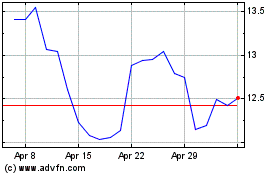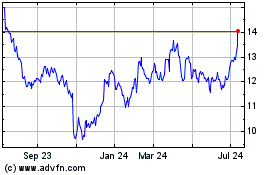By Christina Rogers and Mike Colias
Ford Motor Co. said it plans to start importing its compact
Focus from China, reflecting a wider industry trend that gives auto
makers more flexibility but threatens automotive jobs in the
U.S.
The move, announced Tuesday, is the latest shift in Ford's
approach to the source of production for its once-hot Focus, a
small car the company started building in Michigan earlier in the
decade. Ford had initially planned to move production of the Focus
to Mexico.
The move to Chinese factories, slated for mid-2019, has broad
implications for the U.S. auto industry. Although Ford won't be the
first Detroit company to import cars into the U.S. from China, it
will be by far the highest volume of vehicles to come from Chinese
factories to American dealerships. In 2016, Ford sold 170,000
Focuses in the U.S.
Companies producing in Mexico have been under pressure as the
Trump administration renegotiates the North American Free Trade
Agreement, a decades-old pact that has led several auto makers to
bulk up Mexican head count and production activities. Ford and
rivals have already signaled changes in response to President
Donald Trump's repeated attacks on companies importing cars from
Mexico to the U.S.
The decision to move production of the Focus for the U.S. market
to China comes as many auto makers are retrenching from the
struggling small-car market.
Joe Hinrichs, Ford's global operations chief, said in an
interview that Mr. Trump's push to rewrite Nafta wasn't influential
in Ford's decision to relocate the Focus.
Rather, with small-car sales slumping in the U.S., Mr. Hinrichs
said it made more sense to add production in China, where it is
already retooling its Focus plant for the next-generation model,
rather than spend additional money to convert an existing factory
in Mexico.
"This is really about saving capital, cash to reinvest in the
business elsewhere," Mr. Hinrichs said.
Small cars built by U.S. workers are generally money losers in
the American market because buyers won't pay a premium for them.
The red ink deepens as gas prices fall and demand for
fuel-efficient vehicles fades. Sales of compact cars, such as
Honda's Civic or Chevrolet's Cruze, thrive when fuel is pricey and
buyers want fuel efficiency, but the models require hefty discounts
when gasoline is cheap.
Ford in January decided to move manufacturing of the Focus to
Mexico so it could convert the Michigan factory back to pickups and
sport-utility vehicles. That decision was criticized by Mr. Trump
during the presidential campaign even though it would have
preserved thousands of United Auto Workers jobs.
Critics say moving any product to Mexico is problematic, but
Ford says such moves are necessary to preserve the bottom line.
Ford later softened that blow by saying it would cancel the new
plant planned in Mexico and allocate $700 million in savings to
create jobs at a separate plant in Michigan slated to make electric
cars.
The turn to China may heighten the White House's concerns
because vehicles coming from Asia are typically far less dependent
on U.S. parts than those coming from Mexico.
General Motors Co. last year became the first major auto maker
to rely on China for significant volumes of vehicles to be sold in
the U.S. Buick dealerships have sold more than 30,000 Envision
SUVs, built in northeast China, since it went on sale in 2016.
Sourcing vehicles from China allows global auto makers to make
better use of capacity in the world's largest car market amid a
slowdown in sales growth there. But a combination of factors,
including hefty tariffs and lower logistics costs, means U.S.
workers have essentially no role in the construction of those
vehicles.
Unlike cars built in Mexico, which often carry several
components made by U.S. parts suppliers due to the lack of trade
barriers, the Buick Envision relies on Chinese sources for 88% of
its components, according to the National Highway Traffic Safety
Administration. Only 1% is provided by U.S. or Canadian companies,
the NHTSA says.
Mr. Hinrichs said the decision to relocate the Focus should have
limited impact on North American supplier jobs because the auto
maker has a slew of new models coming that will be built in the
region, including several new SUVs.
The current Focus built in Michigan, which is scheduled to end
production in 2018, gets about 46% of its parts from Canadian or
U.S. suppliers, Mr. Hinrichs said.
Building the next-generation Focus in China rather than in an
existing plant in Hermosillo, Mexico, will save Ford $500 million
annually, helping the No. 2 U.S. auto maker trim costs amid slowing
U.S. volumes and rising expenses related to technology investments,
both of which are pressuring profits.
GM is also signaling a reconsideration of its reliance on
Mexican facilities. In its case, though, GM has said it wants to
use more American-made parts in pickup trucks and large SUVs being
introduced in coming years.
Last week, for instance, the auto maker said it would open a new
supplier park in Texas, expecting the creation of 600 U.S. jobs for
work that would have otherwise been handled by Mexican workers.
In addition to shifting economics and global demand, auto makers
are grappling with political uncertainty in the U.S. as Republican
lawmakers promote a border-adjusted tax that would put imports at a
disadvantage.
The Trump administration is currently preparing to renegotiate
Nafta in ways that could change the rules of the game for auto
makers. For example, some administration officials have backed
tightening the "rules of origin" that spell out how much of a car
has to come from North American in order for the vehicle to be
shipped from Mexico to the U.S. duty free.
Tightening the rules of origin for a car with significant
overseas components could destroy the advantage Mexico has over
other countries, including China. Mexican-assembled cars that don't
meet the rules of origin in Nafta would be slapped with a 2.5%
tariff upon entering the U.S., the same duty that would apply to
cars made in China.
Write to Christina Rogers at christina.rogers@wsj.com and Mike
Colias at Mike.Colias@wsj.com
(END) Dow Jones Newswires
June 20, 2017 14:02 ET (18:02 GMT)
Copyright (c) 2017 Dow Jones & Company, Inc.
Ford Motor (NYSE:F)
Historical Stock Chart
From Mar 2024 to Apr 2024

Ford Motor (NYSE:F)
Historical Stock Chart
From Apr 2023 to Apr 2024
